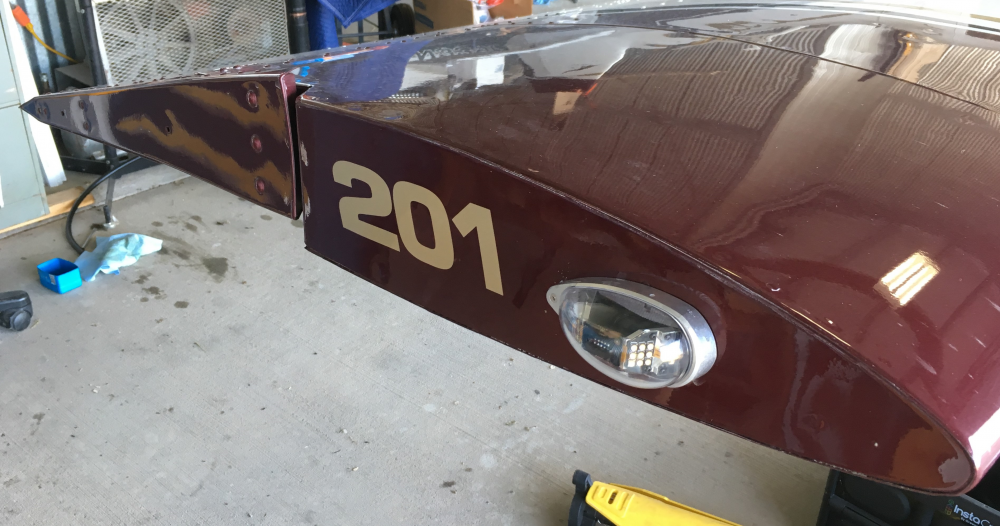-
Posts
639 -
Joined
-
Last visited
-
Days Won
1
Content Type
Profiles
Forums
Blogs
Gallery
Downloads
Events
Store
Everything posted by Blue on Top
-
(it was prior to regulations) Would have been "Experimental" or CAR 3 ... no bird strike requirements. @carusoam You are correct - no windshield.
-
110, 120 ... whatever it takes.
-
Impulse warp drive can't handle a bird strike.
-
Engine stoppage ... and not necessarily where one would guess (at high power on takeoff). Not only Mooney, but Cirrus, too.
-
So is it me or does it seem like there has been a rash of IO-550 engine issues? (not only Mooney aircraft) Or is it that it is the only engine of choice for production these days? I ask because I was asked recently about which Mooney model should be purchased with the caveat of no TCM engines.
-
Hold on there just a moment, Bucko. WTH, now there's fake news, too???? I serious need an attitude adjustment. Blues on Top (again), Ron
-
OMG, yes!!! I knew that something was wrong when I typed it. Thanks for the catch.
-
@PT20J This is EXTREMELY interesting ... and a lot of information. I need to keep my engineering hat off and my mouth shut when I look at this stuff ... lest I say something that will offend someone. But when has that stopped me before? I love Wolfgang Langewiesche's "Stick and Rudder" but AOA is not the angle made by the "wing chord" and the direction of flight. The relative wind is not equal and opposite to the direction of flight .... except in a computer. Leighton Collin's "Takeoffs and Landings" is a good book. To put this in perspective (no, not Garmin in a Cirrus), the forward to Leighton Collin's book was written by none other than Wolfgang Langewiesche. They were really good friends. Leighton is Bob Collin's father and was the originator and publisher of "Air Facts" magazine. There is a good reason that certificated (and military) AOA systems are of two/three types ... they work ... and are designed and proven to be calibrated to the very high accuracy required. They are also expensive. Perception is EVERYTHNIG in sales. Continuing to stalk. I have to know what people are saying
-
I know many of them. Crotchety old farts, but they typically know their stuff.
- 185 replies
-
- 1
-

-
- electric aircraft
- electric motor
-
(and 2 more)
Tagged with:
-
Soooooooo. How much Mooney International stock do you own? I am jealous of people that are less risk tolerant. Personally, I am waaaaaayyyyyyy too much of an engineer, but so far, I think I'm doing okay. Taking less risk is at times actually more risky.
- 185 replies
-
- electric aircraft
- electric motor
-
(and 2 more)
Tagged with:
-
So should I read his two books?
- 185 replies
-
- electric aircraft
- electric motor
-
(and 2 more)
Tagged with:
-
Do you know how much the balance weight went up for the internal balance? It's much cleaner, though.
-
Winglets change the spanwise lift distribution, increasing wing/spar bending moment. If the same vertical surface area of a winglet would be laid flat, it would be more efficient (and the wing/spar bending moments would also be higher ... and higher than a winglet). The most efficient wing is "flat", Winglets were originally designed to allow for a gross weight increase without having to beef up the spar or re-wing the airplane. If airlines really wanted the highest efficiency airplanes they would have longer wings (not winglets) ... and then they would not fit at the gates. PS. Winglets only reduce drag at higher CLs. So, if you want to go faster up high (think "Acclaim"), they might do good. If you're cruising at 5-8K, you'll add drag.
-
-
So, I'll be as PC as possible as I am currently re-reading "How to Win Friends and Influence People" (but I am an engineer). They look good. Burying lights and antennas is always good ... for drag reduction. Their website says that they are for the M20J, M20K, M20 L and M20S, which is a really strange combination (reason shortly). The website also states that they are NOT certificated yet. As for simple drawbacks, if the wingtip is carbon, an antenna will not work inside the wingtip ... especially if it has a copper mesh buried in it for lightening protection. If there is no copper mesh, they'll have to prove to the FAA that when the wingtip takes a lightening strike, nothing inside of it is critical to flight (antenna, strobe, navigation light). But that's not aerodynamics This is a wingtip per FAA definition and NOT a winglet. These actually look like wingtips on the current "Ultras". A wingtip addition doesn't need to re-examine wing bending loads and are not considered "structural." So, the advantages are two. 1) it slightly extends the wingspan, making it very slightly more efficient and 2) it makes the aileron more effective as less airflow will go around the end of a deflected aileron. Aileron forces will be very slightly higher, too, as a direct result. My questioning of the" to-be-approved models is that the "J" (and maybe the "K") has an external (end of the wing) horn balance weight that goes well forward. This wingtip would make that balance weight pop in and out of the wing surfaces, whcih could change aileron forces. How many "L"s exist? Why the "S" and not all the other models? And, specifically for @PT20J ... sorry. A slight upsweep is actually not good. Squared off tips are actually good. The reason is that one wants the wingtip vortices to depart the airplane cleanly. Any roundness will cause the vortices to cling to the airplane and be drawn inward ... slightly shortening the wingspan. Hope this helps -Ron PS. Effect of wingtips/winglets depends on the wing CL. They always add drag, but do they reduce the overall wing drag during climb and/or high altitude cruise? PS2. Per the FAA, a wingtip technically doesn't rise above the wing upper surface. -
-
Honored and humbled. I know very little, but I believe the new company IS working on something.
-
I had to Google that one. Holy cow! That was back before color was invented!
-
There's a thread?
-
Frank Crawford is outstanding! So is Misty!
-
@aviatoreb Agree with you on the multi-emoji idea. I am often self-conflicted in that area. Tragically, they believe that the accident was a stall/spin/spiral (loss of control). PS. This conversation is awesome, but I really, really, REALLY need to get to GoCreate Wichita for work! I'm looking at STCs for both old and new technologies!
- 185 replies
-
- 1
-

-
- electric aircraft
- electric motor
-
(and 2 more)
Tagged with:
-
I think that airplane is history. Crash and burn (order not known); 2 fatalities. Alice also burned during recharge. There are still hurdles to clear, but we won't get there if we don't try. As the saying goes, "If you haven't failed, you're not trying hard enough."
- 185 replies
-
- 1
-

-
- electric aircraft
- electric motor
-
(and 2 more)
Tagged with:
-
(sarcastically) I'm glad Orville and Wilbur didn't have to design an M20 Ultra Acclaim to have their work not be be called useless. The first "practical" airplane wasn't made (through design evolution) until 1908, 5 years after the first 4 flights totaling less than 2 minutes time. What I am proposing is that with $5M, I can STC a current certificated airplane. It may not be practical, but for $5M I have a certificated, electric storage system, distribution system and propulsion system. Now we're just waiting for a better electrical storage/production system to be "practical".
- 185 replies
-
- 1
-

-
- electric aircraft
- electric motor
-
(and 2 more)
Tagged with:
-
Randall Fishman, Sonex and Airbus (e-Fan II) have all flown AT Oshkosh.
- 185 replies
-
- electric aircraft
- electric motor
-
(and 2 more)
Tagged with:
-
It may have been in the Electric Mooney thread, but a couple ex-Mooney engineers are at Bye. Tom Bowen is their Chief Engineer, and Scott Wilson is their Manager of low voltage electronics. George has been at this for years ... well decades. He promised everyone at Cessna that we'd all be flying electric Cessna 172s with solar panels on the wings by 2010. According to the press, they recently received two more $5M investments to build "production" prototypes. That should put a dent in the $100M+ it will take to certify. It's costly and time consuming enough to certify a new airplane but now add in a new technology (electric propulsion, distribution and storage), a composite airframe with high voltage running around and regulations/compliance yet to be written. I wish them all all the best.
- 185 replies
-
- 1
-

-
- electric aircraft
- electric motor
-
(and 2 more)
Tagged with:




